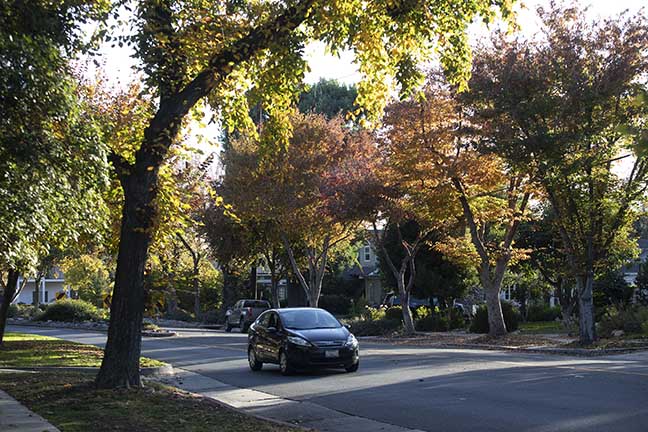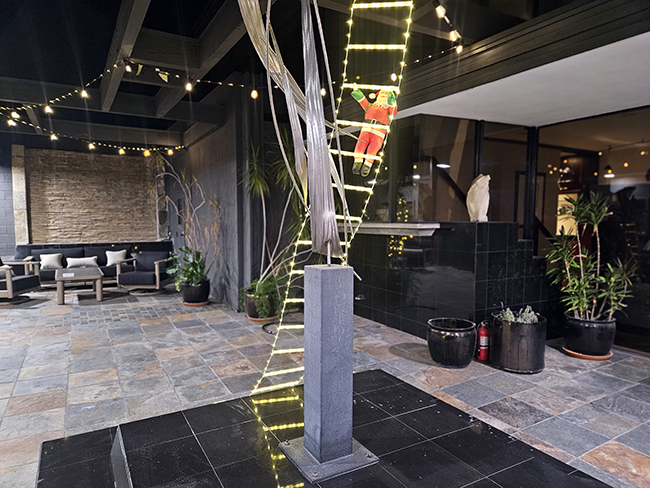City is deep into reevaluating its tree policies

Claremont has begun the process of reevaluating its Urban Forest Policies and Procedures manual with a series of public meetings to get input from residents about priorities for the updated document. Courier photo/Steven Felschundneff
by Steven Felschundneff | steven@claremont-courier.com
Ever since a devastating windstorm in January 2022, Claremont has been in a reflective mood when it comes to its urban forest. There have been private discussions, public meetings and much soul searching, and part of that involves an update to the city’s tree policy manual.
Within weeks of the storm, the City Council set a future priority to review its existing urban forest policies and procedures manual, which could include “development of educational campaigns and mitigation measures.”
Some 300 trees were lost during the storm and scores more were removed in the months following after being deemed unsafe due to wind related damage.
In the summer of 2022 the city asked its tree maintenance contractor, West Coast Arborists, to conduct an evaluation on the health of Claremont’s city-owned trees. The results of the assessment, and an associated mitigation plan, were presented to the Claremont Tree Committee in February, and were then forwarded to the community and human services commission for further consideration.
While West Coast Arborists’ assessment concluded that the city’s urban forest was in generally good health, it also recommended the blanket removal of hundreds of trees prone to failure in another big storm. This included 108 Italian stone pine, 408 red ironbark eucalyptus, and 848 Canary Island pine.
This report did not sit well with many in the tree-loving town, and many critics voiced concern over what they saw as a conflict of interest to ask the very company that would profit from the removals to assess the need to cut down trees. As a result, the community services department agreed to take another look at the mitigation plan and to hire a third party environmental firm to come up with its own assessment of our trees and the urban forest policies and procedures manual.
“In July, the City contracted with Dudek to review the manual,” reads an introduction on the Claremont Community Service Department website. “The goal of the review is to recommend changes that meet industry standards, while considering community character, fiscal responsibility, and compliance with State and local regulations. Additionally, Dudek will make recommendations on reforestation goals, appropriate planting, and infrastructure versus tree conflicts. Recommended revisions will go through a robust community input process.”
Dudek, along with the community services department, has been holding a series of information gathering meetings to learn what Claremont residents feel should be the city’s tree policy.
During one of those meetings earlier this month Kanami Otani and Ryan Allen, urban forest planners with Dudek, presented some of the changes they are proposing based on the feedback received thus far. Residents who wish to weigh in further can do so at the next meeting on December 4.
“When we are talking about the tree policies and guidelines manual we are stepping a little bit away from that overarching urban forester perspective and we are actually talking specifically about the processes, procedures in how the city maintains and manages the tree inventory,” Otani said.
Claremont residents are also concerned about pruning trees during bird nesting season.
Allen said that the nesting season is generally considered to be between March and September and the rules about when to prune were set in place by the federal Migratory Bird Treaty Act, which the U.S. Congress enacted in 1918. He added it is also generally not healthy to prune during summer when trees are stressed by the heat.
Claremont’s existing policy is to conduct “grid pruning” for general maintenance of the city trees from October to March. However, if the city has some funds in the budget left over for tree work, there will occasionally be trimming after March.
Commenters have asked the city set up a policy with its contractors to thoroughly inspect trees for avian activity and nests before any trimming is done, particularly in the spring and summer.
Residents have also asked for greater transparency in the process, and Dudek outlined several areas where the tree policies could change.
The current procedure for hazardous, dead, diseased, dying, emergency and public safety tree removals is as follows: First, the city may remove trees without notice under these circumstances. Second, the city submits monthly lists of removals performed and tree plantings to the community and human services commission. Finally, the list is received two months after the removal or planting once the data verification process has occurred.
The company proposes to leave this policy largely unchanged, other than to require that the removal and planting information be documented with the systemic process that was followed and that it include “tree debris management decisions,” such as whether the tree’s mulch will be available.
The organization also presented its proposal for diseased, dying, and other related tree removals.
“First, we would like to clarify that the goal when assessing a tree for removal is actually always preservation,” Otani said. “We will always recommend to look at all of the mitigation options beforehand.”
First, a city arborist would perform systematic tree health assessment prior to a tree being placed on the removal list. Then, any tree to be removed would be posted publicly, including assessment documentation, giving the public 15 days to respond. If someone protests the removal during this time, the city will identify those trees and a third party arborist would assess it at an additional cost. If the tree has pests or a pathogen there would be lab work, which also comes with a cost. A removal or mitigation recommendation would be made by an outside service. Finally, an update to the protested tree removals must be posted publicly, with additional assessments including paperwork and photos.
The next community meeting to discuss the tree plan takes place at 7 p.m. Monday, December 4 at the City Council chamber. The plan will then go to the tree committee, followed by the community and human services commission, before finally landing on a City Council agenda sometime next year.
1 Comment
Submit a Comment
You must be logged in to post a comment.










I’ve been concerned that the “City of Trees” will become the City of Fire” unless we move trees farther apart and cut down known “torch trees” as climate change heats our planet up.